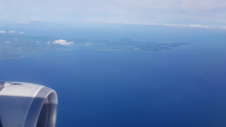Ocean / Sea
Oceans are the largest contiguous bodies of water on Earth.
There are five officially recognized oceans:
- Pacific Ocean (Pacific) – the largest and deepest ocean
- Atlantic Ocean (Atlantic) – between the Americas and Europe/Africa
- Indian Ocean – between Africa, Asia, and Australia
- Southern Ocean (Antarctic Ocean) – surrounds Antarctica
- Arctic Ocean (North Polar Ocean) – surrounds the North Pole
"Sea" is a general term for large expanses of salt water, often part of an ocean or almost entirely enclosed by land.
Examples:
- Marginal seas – at the edge of an ocean, e.g., the North Sea (part of the Atlantic)
- Inland seas – almost or completely surrounded by land, e.g., the Mediterranean Sea, the Black Sea
- Intracontinental seas – such as the Caspian Sea (actually a huge salt lake)
The difference, simply put:
- Ocean → very large, forming the Earth's main body of water
- Sea → smaller, often part of an ocean or surrounded by land
The term "Seven Seas", still in use today, encompasses the waters historically most important for maritime trade. In addition to the three oceans (excluding the Antarctic Ocean), these include the four great "Mediterranean Seas": largely landlocked marginal seas of the oceans that are/were so important for maritime trade that they were considered independent seas in maritime terms. The Seven Seas are therefore:
- the Atlantic Ocean (Atlantic)
- the Indian Ocean (Indian)
- the Pacific Ocean (Pacific, Pacific, or Great Ocean)
- the Arctic Mediterranean (North Polar Ocean)
- the American Mediterranean (Caribbean Sea and Gulf of Mexico)
- the Austro-Asiatic Mediterranean (bordered by the Sunda Islands, Australia, New Guinea, the Philippines, and mainland Asia)
- the European Mediterranean
Oceans are the largest contiguous body of water on Earth—vast, salty, and deep.
They cover about 71% of the Earth's surface and contain about 97% of our planet's total water.
Characteristics of an Ocean
- Size: Millions of square kilometers
- Depth: Often several thousand meters (the Mariana Trench in the Pacific is over 11 km deep)
- Salinity: Average about 3.5%
- Currents: Such as the Gulf Stream or the Humboldt Current, which influence climate and weather
- Biodiversity: From tiny plankton to giant whales
Ocean biomass includes all living organic material in the sea – from microscopic bacteria to giant whales.
In geography and biology, this is often referred to as marine biomass.
Distribution of Biomass
- Plankton (especially phytoplankton = microscopic algae) accounts for the largest proportion of primary production, but is relatively small in terms of biomass because it is quickly consumed or decomposed.
- Bacteria & Microorganisms – present in large numbers, especially in surface waters and sediments.
- Fish – estimated to be several hundred million tons, heavily influenced by fishing.
- Marine mammals – very small proportion of total biomass.
- Deep-sea organisms – significant overall, but difficult to accurately measure.
Source Pic, own work, H. Rufer
Reference Text: https://de.wikipedia.org/wiki/Ozean

